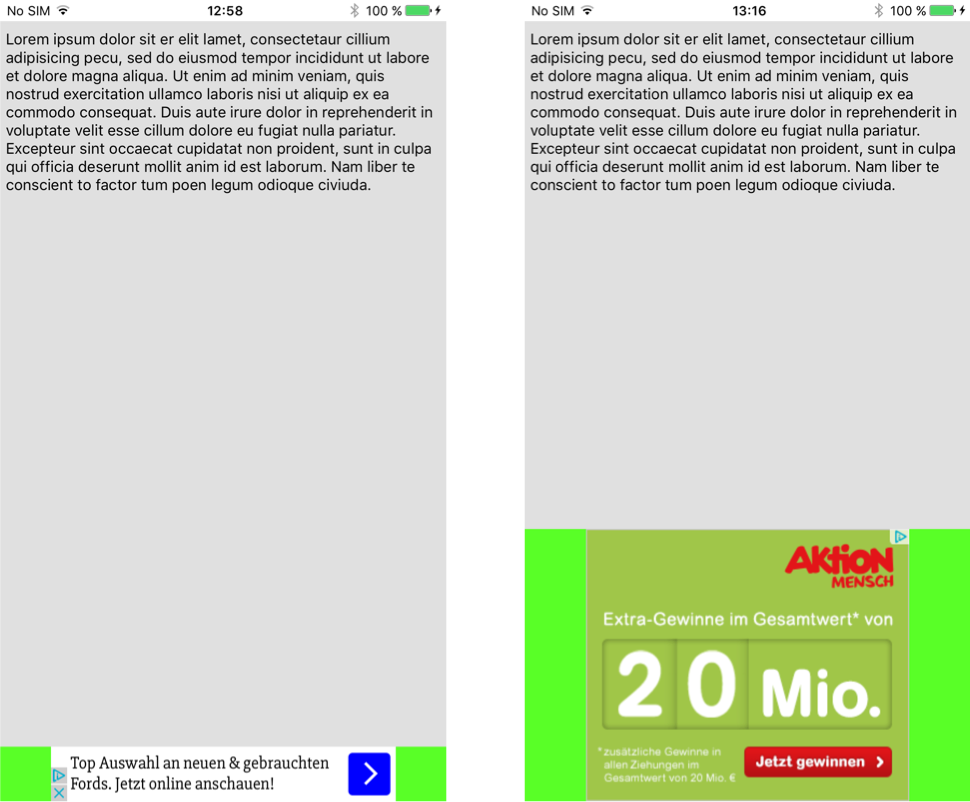Wiki
Clone wikiBanner Sample / Multi-size Banner (AATKit 2)
Multi-Size Banner Placement
Index:
Multi-Size banner placements can present banner of varying sizes. For instance it is possible to display a banner of the standard size 320x53, followed by a medium rect angle of size 300x250 within the same placement.

(Note: the green background is an ad container (UIView), into which the placement view is added. It represents the space that is reserved for a multi-size banner placement's view.)
Meta Information
The following sizes are supported for Multi-Size Banner.
- 300x250
- 320x53
- 320x75 (DFP only)
- 320x100 (DFP only)
- 320x150 (DFP only)
- 468x60
- 768x90
Please contact the AddApptr support via support@addapptr.com, in order to let us know which formats you would like to use in your app. The AddApptr team will setup the backend accordingly.
Creating a Multi-Size Banner
A Multi-Size Banner is created by calling the method:
#!objective-c + (nonnull id) createPlacementWithName:(nonnull NSString *) placementName andType:(AATKitAdType)type
AATKitBannerMultiSize.
This process is just the same as for the normal banner placement.
Example:
Objective-C:
#!objective-c [AATKit createPlacementWithName:@"MultiSizeBanner" andType:AATKitBannerMultiSize];
#!swift AATKit.createPlacement(withName: "MultiSizeBanner", andType: .bannerMultiSize)
Requesting an Ad
A Multi-Size Banner supports manual and automatic reload. For manual reload:
#!objective-c + (bool) reloadPlacement:(nonnull id) placement;
For automatic reload:
#!objective-c + (void) startPlacementAutoReload:(nonnull id) placement;
Reacting on the Multi-Size Banner Callback
When a Multi-Size Banner is successfully loaded a new callback is invoked.
#!objective-c - (void) AATKitHaveAdOnMultiSizeBanner:(nonnull id) placement withView:(nonnull UIView*) placementView;
placementView provided via the callback. The AATKit is providing an autoreleased placementView instance.
Also, since the AATKit has no ownership of any (potential) previous placementView, the programmer may keep the old instance around in case of a animation or alike.
Objective-C:
#!objective-c - (void)AATKitHaveAdOnMultiSizeBanner:(id)placement withView:(UIView *)placementView { UIView *oldAdView = self.currentlyShownAdView; self.currentlyShownAdView = multiSizeBannerView; ... }
#!swift func aatKitHaveAd(onMultiSizeBanner placement: AATKitPlacement, with placementView: UIView) { let oldView = currentlyShownAdView currentlyShownAdView = placementView ... }
For successfully loaded Multi-Size Banner ads the callback - (void) AATKitHaveAd:(nonnull id) placement; will not be invoked.
In case no ad could be loaded on a Multi-Size Banner placement, the callback - (void) AATKitNoAds:(nonnull id) placement; is invoked. For this case, no new callback has been introduced.
Displaying a Multi-Size Banner
In order to show a Multi-Size Banner, it's view has to be positioned on the screen, similar to regular banner placements. Since a new placement view is provided each time the Multi-Size Banner specific callback is invoked, a potential previous placement view has to be disposed by the programmer, and a new one has to be positioned. Since the UIView frame can change each time Multi-Size Banner callback is invoked the programmer has to adapt the space available according to the view's frame.
Sample App
Updated